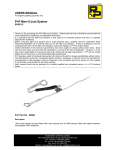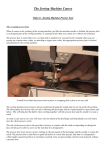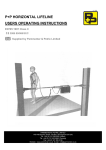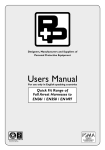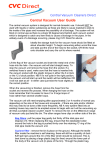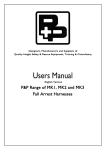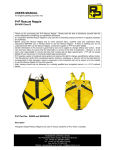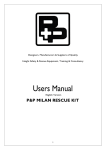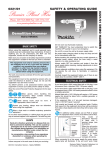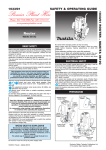Download Manual - Safe and Secure Fall Protection Ltd
Transcript
Designers, Manufacturers and Suppliers of Personal Protective Equipment Users Manual English Version Britannia Range of Fall Arrest Harnesses 1 Thank you for purchasing this P+P Britannia Harness. Please take the time to familiarise yourself with the correct fitting and adjustment procedure. It is imperative that this harness is only used for its intended purpose and that it is subject to a periodic recorded detailed inspection by a competent person. Before using this harness and to avoid personal injury, carefully read and understand these instructions BEFORE use or training others to use the harness. If there is anything you do not understand, DO NOT use the harness, contact the supplier or P+P for advice. P+P can offer suitable training for you and your workforce. Contact P+P for further details. Certain information in this manual is governed by law and is subject to change without prior notice. Great care has been taken to ensure that the information is correct at the time of publication. However, it is the user’s sole responsibility to ensure that they fully comply with all legal requirements. P+P will not accept liability for any inaccuracy or incorrectly stated legal requirements. P+P operate a policy of continuous improvement and reserve the right to change specifications without notice. The Manufacturer and/or their recognised agents, directors, employees or insurers will not be held liable for consequential or other damages, losses or expenses in connection with or by reason of or the inability to use the harness for any purpose. Note; training should only be delivered by a suitably qualified and competent person, i.e. a P+P product trainer. The product name, unique serial number and date of manufacture will be found on the product label either sewn into or onto the Harness’ webbing. Always make sure the product label is present showing both the serial number and date of manufacture and that it matches the Inspection Record Document / this manual. If the numbers are not legible on the Product Label or do not match the Inspection Record Document / this manual – Do Not Use the Harness! The Harness along with all your other Fall Protection PPE must be subjected to a pre-use check each time before use. Failure to inspect the Harness correctly could cost you your life. You should be trained to carry out a pre-use check. Detailed recorded inspections should only be carried out by a trained competent person, appointed by the employer. Additionally recorded interim inspections may be required where risks from transient arduous working environments exist. This should be identified through Risk Assessment. The pre-use check must include (but is not limited to): • Check all webbing for signs of cuts, abrasions, fraying, tears, burns, mould, discolouration or chemical attack. If the Harness has been subject to paint overspray, it must not be used. • Check all stitching for signs of loosening, pulling or cut thread. There must be no evidence of damaged stitching on either side of the stitch pattern. • Buckles and ‘D’ Rings MUST be free from rust, excessive wear, distortions or cracks. If during the pre-use check any part of the Fall Arrest System is found to be or believed to be faulty, DO NOT use it. Remove ALL components from site to ensure that they cannot be used by anyone. Modifications and Repairs No repairs, modifications or alterations are to be carried out on this Harness. Description P+P offer a full range of Britannia Harnesses to suit your needs. This manual covers the design features of all P+P Britannia Harnesses and it is important that you read and understand it. With your harness, and using these instructions, work through the various fittings and adjustments. Fall Arrest All P+P Britannia Harnesses are designed for fall arrest. Every harness is fitted with a dorsal (rear, between shoulders) 'D' ring attachment point identified by the letter ‘A’. Identification takes the form of a letter ‘A’ printed onto adjacent webbing, etched into the ‘D’ ring or stamped into the plastic dorsal plate. There may also be a sternum (front, centre of breast bone) 'D' ring, in which case the letter ‘A’ will be etched into the ring or printed onto adjacent webbing. Fall arrest lanyards/equipment must only be attached to a ‘D’ ring which is clearly identified by the letter ‘A’. Note: Identification of fall arrest attachment points is a recent change to equipment standards and earlier harnesses will not be marked. If in doubt contact the supplier or P+P for advice. Work Positioning Some P+P Britannia Harnesses have an integral work positioning belt. The belt provides 2 cranked side 'D' rings (one on each hip), for the attachment of a work positioning lanyard. Rescue Some P+P Britannia Harnesses have an integral overhead rescue attachment. This attachment is for rescue from confined spaces or similar circumstances. Inspection This manual contains a Declaration of Conformity and a section for recording your periodic ‘Detailed Inspections’. On the back page of this manual is a space for the user to record the product name, unique serial number and date of manufacture. 1 Chest Strap Adjustment Fittings and Adjustments The following section deals with the types of fittings found on P+P Britannia Harnesses and their uses. Three Bar Slide A simple metal ‘buckle’ shaped fitting which is either retained in place by webbing or fitted to the end loop of a webbing strap. It can be ‘slid’ along the webbing and will remain where positioned with minimal creep. Square Link Fitted to the end of a webbing strap and designed to receive and retain a three bar slide. The three bar slide and square link allow easy connection, separation and adjustment of chest straps when fitting or removing the harness. At the Front 'D' Ring Adjuster At the Back Sternum 'D' Ring Chest Strap Adjuster Waist Belt Buckle 3 Bar Slide & Square Link 2 1 1 2 Square 3 Bar Link Slide 3 3 This buckle has to be threaded in a specific manner to ensure a secure fit. It is only fitted to harnesses that incorporate a Work Positioning Belt. Web Retaining Loop A sewn webbing loop used to retain the end of a leg strap. When adjustment has been finalised, the loop should be moved as close to the loose end of the webbing strap as possible. Plastic Slider The adjustable leg straps are fitted with two plastic sliders used to retain the end of the strap. When adjustment has been finalised, one slider should be moved as close to the three bar slide as possible and the other to the loose end of the webbing strap. Elastic Strap Retainers Adjustable straps are fitted with Elastric an elastic secured retainer to Strap retain the end of the strap. Retainer Quick Fit Buckle The Quick Fit buckle is permanently attached to enable speedy deployment.To tighten a fitting, pull Tab the free end of the strap until the Strap required fit is achieved. To release Free End the fitting, raise the buckle’s tab Tighten fully back and pull, the webbing will feed gently through. Quick Release Buckle Connection of this Release Tab Female buckle is a simple push Male fit. To release the Buckle, both release tabs must be moved back simultaneously, if not, the Buckle will remain Release connected. The mechanism MUST be kept clean at all times and you should NOT Release use any lubricants to ease its use. Release 2 Attachment Points Tool Loops & Swivel Hooks Tool Loop Dorsal ‘D’ Ring and Sternum ‘D’ Ring The two fall arrest attachment points, identified with a letter ‘A’ (see page 1 paragraph 2 ‘Fall Arrest’) are the only ones to be used to connect you in the harness to a fall arrest system. Although you may have fall arrest lanyards and other fall arrest attachment devices attached to both of your fall arrest ‘D’ rings, only one means of attachment should be connected to your anchorage point at anyone time. If attaching to the Dorsal 'D' ring of a 'rescue' model, make sure that the integral overhead rescue attachment is either retained or moved to the side of the 'D' ring. Rear Fall Arrest ‘D’ Ring The rear fall arrest 'D' ring is Dorsal 'D' Ring retained within a Dorsal plate where the shoulder straps Dorsal cross over at the back of the Plate harness. This 'D' ring is identified with a letter ‘A’ as it is for fall arrest attachment. (see page 1 paragraph 2 ‘Fall Arrest’) The webbing 'slides' through the 'D' Ring on the Dorsal Plate and from time to time may need to be re-adjusted. Front Fall Arrest ‘D’ Ring Swivel Hook Loops and swivel hooks are fitted to some waist belts and are intended for use as attachment points for light tools or communication equipment. THESE LOOPS / SWIVEL HOOKS ARE NOT TO BE CONNECTED TO ANY LANYARD, RETRIEVAL SYSTEM, STRUCTURE OR PERSON. Breathable Top Breathable tops are fitted to some Britannia Harnesses. These are for comfort only and do not form part of the structure of the harness. Waiscoat If the harness has a front fall arrest ‘D’ ring,it will be on the chest strap and the shoulder straps should be adjusted so that it sits on your sternum / breast bone. Rescue ‘D’ ring If the harness has an integral overhead rescue attachment, it must not be used for fall Rescue arrest, other than in 'D' Ring conjunction with a retractable type fall arrester to BSEN 360 anchored above the user. The attachment should be either folded and stored in the Velcro pocket on the waist coated versions or attached with the Velcro loop to the chest strap at the back. The attachment must always be behind the head, never in front. Waistcoats are fitted to some Britannia Harnesses. These are to aid the donning process and do not form part of the structure of the harness. 3 Work Positioning Attachment Point 'D' Ring Use only with an approved Work Position Work Positioning Lanyard to Attachment Point 'D' Ring support the user whilst working at height when needing a hands free environment. NEVER detach yourself from the fall arrest equipment when using the work position attachment point 'D’ rings. 1 3 2 Fitting Your Harness The following instructions cover all harnesses in the P+P Britannia Range and all variations of fitting. Some parts such as adjustable chest straps, waist belts and integral overhead rescue attachments are only fitted to specific models. The sequence for the Britannia Range of Fall Arrest harnesses is very similar, except the way in which it is performed. The harness is normally worn outside of your clothing. Make sure that your clothing is correctly fitted and that you secure all zips and buttons. Remove ALL items from your pockets, hanging items such as key clips, mobile phone or radio. Double check that there are no items positioned between the webbing and your body. Such items could cause discomfort or injury in the case of a fall. Fig. a WARNING This Harness must only be used by persons who are medically fit to do so. If you have any medical condition, are recovering from any medical condition or suffer from any physical or mental disability, you MUST seek professional medical advice before using this Harness. Fig. b 5. Lift the harness by the dorsal ‘D’ ring and make sure all straps hang straight. Untangle any which are not. Fitting Stage One (shoulder and chest) 1a. If the leg straps are fitted with three bar slide and square link or a quick release buckle, fit the harness over both shoulders with the dorsal ‘D’ ring behind you. Place your arms through the shoulder straps. The harness is ‘in side out’ if the logo on the webbing is not outermost. 1b. If the leg straps are fixed with quick fit buckles, place the harness on the floor and ‘step into’ both leg strap loops. Raise the harness and check that the dorsal ‘D’ ring is behind you. Raise the harness over both shoulders and place your arms through the shoulder straps. The harness is ‘in side out’ if the logo on the webbing is not outermost. 2. (Rescue version without a waistcoat) make sure that the integral overhead attachment is attached with the Velcro loop to the chest strap, on the outside of the harness, behind your head and NOT between you and the harness itself. 3. Adjust both shoulder straps to bring the chest strap squarely in line with your sternum (breast bone). Make sure both shoulder straps are adjusted to an equal length. Preparation 1. Carry out a pre-use check of the harness before proceeding. If any faults are found or you are not 100% sure of the harness’s condition or suitability, STOP. 2. Remove any attached lanyard or similar connected to any ‘D’ ring. 3a. Undo any three bar slide and square link fitted to chest strap or leg straps and loosen fully. 3b. Undo the Quick Release Buckles where fitted to the chest strap, waist belt or leg straps. 3c. Loosen fully the Quick Fit Buckles where fitted to shoulder straps or leg straps. 4. If an integral overhead rescue attachment is fitted, carefully fold it back and secure within the yellow pouch (fig. a) or with the Velcro loop (fig. b). 4 FIT Checklist 3a. Where applicable you will need to adjust the shoulder straps to bring the sub-pelvic strap up to lie/sit at the top of our thigh muscle, across the lower area of your rump. Make sure both straps are adjusted to an equal length. 4. Connect the chest strap by passing the three bar slide through the square link.Then turn the three bar slide and align it with the square link ensuring that the straps are not turned or twisted. 5. Adjust the chest strap (when adjustable) as necessary to bring the strap to a snug fit. Secure excess strap under the elasticated or Velcro strap retainer. Realign the sternum ‘D’ ring to bring it central to the chest. Note; try to achieve a snug fit without creating discomfort or restricting natural movement. Fitting Stage Two (legs) 1. If you stepped into the leg strap loops, stand upright and straight then check that both leg straps are not twisted. If the leg straps are separated, stand upright and straight. Reach behind and place your right hand onto the rear right hand leg strap and feed its end through your legs. Take the strap end with your left hand and check that the strap is not twisted. 2. Connect the rear portion of the right hand leg strap to the front section of the right hand leg strap ensuring that the straps are not turned or twisted. 3. Repeat this process with the left hand leg strap. 4. CAUTION; Positioning of these straps is of the utmost importance. Failure to ensure that both leg straps pass between your legs, are not twisted and are adjusted so they sit into your groin, may cause serious injury during an arrested fall. 5. Care should be taken to ensure that the sub-pelvic strap is correctly positioned at the top of your thigh muscle. It should not be at the base of your spine. 6. Adjust the straps to make a snug fit ensuring that both straps are positioned as high as possible between the inside leg and groin. Finally, secure excess strap. Fitting Stage Three (Waist Belt Only) 1. Only when the harness has been fitted and adjusted should you secure the waist belt. 2. Either Pass the free webbing strap behind the buckle's knurled bar (to the left as viewed) and pull it through the buckle. Move the strap over the knurled bar and feed back through the front of the buckle or bring the two ends of the Waist Belt together and connect the male and female parts of the Quick Release Buckle. 3. Hold the free end webbing strap and pull until a snug fit is achieved. To secure in place, move the free end over the buckle and pass it through the tail of the buckle. 4. Secure excess strap under the elasticated retainer. Make it a habit to follow this check list every 2 hours of use, IT MAY SAVE YOUR LIFE. • Shoulder straps evenly adjusted. • Leg and chest connectors joined correctly. • Chest strap adjusted and positioned squarely over sternum. • Dorsal ‘D’ ring positioned centrally. • Leg straps evenly adjusted and CORRECTLY POSITIONED. • Waist belt secure. • Integral overhead rescue attachment retained or positioned behind shoulders. • All excess strapping secured behind plastic sliders, elasticated or Velcro retainers. Attaching to the harness You must only use P+P approved and recommended lanyards, connectors, fall arresters and ancillary equipment. Any lanyards, connectors, fall arresters or ancillary equipment MUST be accompanied by a Declaration of Conformity and a valid inspection record. RESCUE PLAN As part of your risk assessment, you MUST have in place a rescue plan to deal with any emergency which may occur during use. Access to the user, directly or indirectly, and their safe retrieval is of paramount importance, including preparations for dealing with potential Post Fall Suspension Trauma. Cleaning and Storage You may clean the harness of light soiling, using warm water (40ºC max) with pure soap or mild detergent. Heavy deposits of creosote or grease may be removed with a diluted solution of heavy detergent and water. Avoid getting soap/detergent into adjuster buckles. After cleaning, rinse thoroughly with fresh clean water then remove excess water with a dry cloth. Finally, allow the harness to dry naturally then give it a full inspection before storing. Store in a cool dry place, which will protect the harness from extreme humidity, direct heat and sunlight. Allocate a storage area specifically for your harness. If the harness is wet, allow it to dry naturally BEFORE storing. Chemical Attack If the harness comes in contact with any chemicals, you MUST immediately remove it from service and check with P+P for the potential of degradation. If you have any doubts as to the safe condition of the harness remove it from service and have it destroyed. 5 Service Life Each P+P Britannia harness has a maximum working life of 5 years from date of first use, provided it is correctly stored and maintained. However, if the harness fails any inspection it MUST be destroyed. See the Statement of Obsolescence within this manual. IMPORTANT NOTE Each P+P harness is designed to arrest a fall from height ONCE ONLY. If subjected to an arrested fall the harness must be withdrawn from service and destroyed to ensure that it is not used again. P+P harnesses are tested and certified to the following: • Fall Arrest Harness to EN361. • Fall Arrest Harness incorporating a Waist Belt to EN358. • Fall Arrest Harness incorporating an Integral Overhead Rescue Attachment to EN1497. Note; to comply with the above standard, the harness is subjected to testing with a 100Kg solid rigid dummy, which does not have the capability of absorbing any energy. P+P recommend that the users’ body weight, including clothing and tools, does not exceed the weights shown in the table below. However, what must also be considered by the user or specifier when having concerns about body weights of 100Kg + is the fall factor and energy absorbing capabilities of the attachment device I.E; Energy Absorbing Lanyard or Retractable Type Fall Arrestor. Dorsal ‘D’ ring (fall arrest) 130kg Sternum ‘D’ ring (fall arrest) with full chest strap 130kg Sternum ‘D’ ring (fall arrest) with partial chest strap (2020) 100kg Overhead rescue attachment ‘D’ ring 125kg Work Positioning Waist Belt 130kg About This Manual This User Manual is for English speaking countries only. If you require this manual in a different language, please Contact P+P. When this Harness is sold on, this manual must accompany the Harness. Product Details The Product Name, Product Code, Serial Number and Date of Manufacture of the Harness should be entered on the back page of this manual for future reference and inspection records. 6 Designers, Manufacturers and Supplies of Personal Protection Equipment Statement of Obsolescence Due to the ingress of dirt and grit, chemical contamination, edge and surface damage, ultraviolet light degradation, and general wear and tear Fall Protection Equipment manufactured from synthetic fibres (webbing and/or rope) are subject to a manufacturer’s statement of obsolescence which is a requirement of BS EN 365:2004 a European Product Standard. Any item of Fall Protection Equipment manufactured by Pammenter and Petrie Limited with synthetic fibre components (webbing and/or rope) is subject to a maximum working life of 5 years from the recorded date of first use, provided that the item has been correctly stored, maintained and subjected to regular inspections by a trained and competent person. However, if the item fails any inspection it MUST be destroyed. Any item of Fall Protection Equipment manufactured by Pammenter and Petrie Limited may be stored for a maximum of 2 years and still give the potential 5 year working life – provided it remains in the original manufacturer’s packaging. Once the product is taken from this original packaging for the first time this date becomes the “date of first use”, which should be recorded on the Inspection Record and the 5 year working life begins. Reference should also be made to the British Standard BS 8437:2005 – “The code of practice for selection, use and maintenance of personal fall protection systems and equipment for use in the workplace” – clause 13.2 Lifespan, which states: “Some equipment is given a lifespan or obsolescence date by the manufacturer. Equipment that has reached such a limit, which has not already been rejected for other reasons, should be withdrawn from service and not used again, unless or until confirmed by a competent person, in writing, that it is acceptable to do so.” It should be noted that inspections carried out by a trained and competent person are only visual and tactile observations of the condition of the product; they are not testing the residual strength of the equipment. All synthetic fibres deteriorate slowly with age regardless of use and as a result Pammenter and Petrie Limited strongly advise all users of Fall Protection Equipment to follow the manufacturer’s statement of obsolescence. For further advice on this statement, as well as training in the use and inspection of Fall Protection Equipment, please contact Pammenter and Petrie Limited. Pammenter & Petrie Limited, 140 – 146 Brearley Street, Hockley, Birmingham B19 3XJ, England. Tel: +44 (0)121 359 4561 Facsimile: +44 (0)121 359 4136 e-mail: [email protected] website: www.ppsafety.co.uk Registered in England No. 1493537 7 Designers, Manufacturers and Supplies of Personal Protection Equipment EC DECLARATION OF CONFORMITY The manufacturer in the Community Pammenter and Petrie Limited, 140-146 Brearley Street, Hockley, Birmingham B19 3XJ United Kingdom Declares that the new PPE described hereafter Britannia Range of MK1 Harnesses, Britannia FRS MK2 Harness - 90099MK2 and Britannia Super MK2 Harness - 90049MK2. is in conformity with the provisions of Council Directive 89/686/EEC and, where such is the case, with the national standard transposing harmonized standard numbers: BSEN 361:2002 and BSEN358:2000 is identical to the PPE which is subject to EC certificate of conformity numbers: BSEN 361/04/016 dated 18 October 2004, BSEN361/08/001 dated 7 March 2008 and BSEN 361/08/002 dated 17 March 2008 issued by TUV NEL Limited, East Kilbride, Glasgow, G75 OQU, United Kingdom. EC Notified Body No. 0320 is subject to the procedures set out in Article 11 point B of Directive 89/686/EEC under the supervision of the approved body: The British Standards Institute, 389 Chiswick High Road, London W4 4AL, United Kingdom. EC Notified Body No. 0086 Done at: Birmingham, United Kingdom. on: 18 March 2008 Malcolm Perry H&S/TECHNICAL MANAGER Pammenter & Petrie Limited, 140 – 146 Brearley Street, Hockley, Birmingham B19 3XJ, England. Tel: +44 (0)121 359 4561 Facsimile: +44 (0)121 359 4136 e-mail: [email protected] website: www.pammenter.co.uk Registered in England No. 1493537 8 9 / / / / / / / / / / / / / / / / / / / / / / / / / / / / / / / / / / Date Pass/ Fail Comments / Actions Supplier: ......................................................... Date Purchased: ……/……/…… / / / / / / / / / / / / / / / / / / / / / / / / / / / / / / / / / / Next Inspection Due Print Name Signed User Name:.............................................................. Date First Used: ……/……/…… INSPECTION RECORD This Pammenter and Petrie Limited Britannia Fall Arrest Safety Harness has been tested and CE marked to: BS EN 361:2002 and when applicable to BS EN 358:2000 and EN 1497:1996. Certified by Approved Body: TUV NEL Limited, East Kilbride, Glasgow, G75 OQU, United Kingdom. EC Notified Body No 0320. Pammenter and Petrie Limited operate a Quality Management System to BS EN ISO 9001:2000 controlled and audited by: The British Standards Institute, 389 Chiswick High Road, London W4 4AL, United Kingdom. EC Notified Body No 0086. PRODUCT NAME ............................................................... PRODUCT CODE: .............................................................. SERIAL NO.: .......................................................................... DATE OF MANUFACTURE: ............................................. Designers, Manufacturers and Suppliers of Personal Protective Equipment P+P Limited, 140 – 146 Brearley Street, Hockley, Birmingham B19 3XJ, England. Telephone: 0121 359 4561 Facsimile: 0121 359 4136 Email: [email protected] Website: www.ppsafety.co.uk This Manual and its contents © P+P Limited 2008 Britannia Range of Fall Arrest Harnesses Manual V 1.0308 All rights reserved. No part of this publication may be reproduced, stored in a retrieval system, or transmitted, in any form or by any means, electronic, mechanical, photocopying, recording or otherwise, without the prior permission of P+P Limited. Design, artwork, text and layout by Textwrite Publications Limited, Barrow – Upon – Humber, North Lincolnshire. Tel: 01469 532 095 www.textwritepublications.co.uk











